Abstract
This paper derives a new boundary integral equation (BIE) formulation for plane elastic bodies containing cracks and holes and subjected to mixed displacement/ traction boundary conditions, and proposes a new boundary element method (BEM) based upon this formulation. The basic unknown in the formulation is a complex boundary function H(t), which is a linear combination of the boundary traction and boundary displacement density. The present BIE formulation can be related directly to Muskhelishvili's formalism. Singular interpolation functions of order r −1/2 (where r is the distance measured from the crack tip) are introduced such that singular integrand involved at the element level can be integrated analytically. By applying the BEM, the interaction between a rigid circular inclusion and a crack is investigated in details. Our results for the stress intensity factor are comparable with those given by Erdogan and Gupta (1975) and Gharpuray et al. (1990) for a crack emanating from a stiff inclusion, and with those by Erdogan et al. (1974) for a crack in the neighborhood of a stiff inclusion.
Similar content being viewed by others
REFERENCES
Ablowitz, M.J. and Fokas, A.S. (1997). Complex Variables: Introduction and Applications. Cambridge University Press, Cambridge.
Blandford, G.E., Ingraffea, A.G. and Liggett, J.A. (1981). Two-dimensional stress intensity factor computations using the boundary element method. International Journal of Numerical Methods in Engineering 17, 387–404.
Bonnet, M. (1995). Regularized direct and indirect symmetrical variational BIE formulations for 3-dimensional elasticity. Engineering Analysis with Boundary Elements 15, 93–102.
Bonnet, M. (1999). Boundary Integral Equation Methods for Solids and Fluids. Wiley, Chichester.
Brebbia, C.A. (1984). The Boundary Element Method for Engineers. Pentech Press, London.
Chau, K.T. and Wang, Y.B. (1999). A new boundary integral formulation for plane elastic bodies containing cracks and holes. International Journal of Solids and Structures 36, 2041–2074.
Crouch, S.L. (1976). Solution of plane elasticity problems by the displacement discontinuity method. International Journal of Numerical Methods in Engineering 10, 301–343.
Cruse, T.A. (1969). Numerical solutions in three-dimensional elastostatics. International Journal of Solids and Structures 5, 1259–1274.
Cruse, T.A. (1979). Two-and three-dimensional problems of fracture mechanics. Chapter 5 in Developments in Boundary Element Methods, Vol. 1 (Edited by P.K. Banerjee and R. Butterfield), Applied Science Publishers, London.
England, A. H. (1971). Complex Variable Methods in Elasticity. Wiley-Interscience, London.
Erdogan, F. and Gupta, G.D. (1975). The inclusion problem with a crack crossing the boundary. International Journal of Fracture 11, 13–27.
Erdogan, F., Gupta, G.D. and Ratwani, M. (1974). Interaction between a circular inclusion and an arbitrarily oriented crack. Journal of Applied Mechanics 47, 1007–1013.
Frangi, A. and Novati, G. (1996). Symmetric BE method in two dimensional elasticity: evaluation of double integrals for curved elements. Computational Mechanics 19, 58–68.
Gaul, L. and Schanz, M. (1997). Boundary element calculation of transient response of viscoelastic solids based on inverse transformation. Meccanica 32, 171–178.
Gharpuray, V.M., Keer, L.M. and Lewis, J.L. (1990). Cracks emanating from circular voids or elastic inclusions in PMMA near a bone-implant interface. Journal of Biomedical Engineering 112, 22–28.
Ghosh, N., Rajiyah, H., Ghosh, S. and Mukherjee, S. (1986). A new boundary element method formulation for linear elasticity. Journal of Applied Mechanics 53, 69–76.
Isida, M. and Noguchi, H. (1983). Plane problems of arbitrary located cracks in an infinite matrix containing a circular inclusion. Transactions, Japan Society of Mechanical Engineers 49, 147–155.
Lachat, J.C. and Watson, J.O. (1976). Effective numerical treatment of boundary integral equations: A formulation for three-dimensional elastostatics. International Journal of Numerical Methods in Engineering 10, 991–1005.
Lu, J.K. (1995). Complex Variable Methods in Plane Elasticity. World Scientific, Singapore.
Muskhelishvili, N.I. (1975). Some Basic Problems of the Mathematical Theory of Elasticity. Noordhoff International, Leiden.
Muskhelishvili, N.I. (1977). Singular Integral Equations. Noordhoff International, Leiden.
Portela, A., Aliabadi, M.H. and Rooke, D.P. (1992). The dual boundary element method: effective implementation for crack problems. International Journal of Numerical Methods in Engineering 33, 1269–1287.
Rizzo, F.J. (1967). An integral equation approach to boundary value problems of classical elastostatics. Quarterly of Applied Mathematics 25, 83–91.
Sherman, D.I. (1939). On the solution of the plane static problem of the theory of elasticity for displacements, given on the boundary. Doklady, A.N. S.S.S.R. 27, 911–913 (in Russian).
Sherman, D.I. (1940a). The mixed problem of the static theory of elasticity for plane multiply connected regions. Doklady, A.N. S.S.S.R. 28, 29–32 (in Russian).
Sherman, D.I. (1940b). The plane problem of the theory of elasticity with mixed boundary conditions. Trudy Seismologiczesk Insts. A.H., S.S.S.R., No. 88 (in Russian).
Sherman, D.I. (1943). On a mixed problem of the theory of elasticity. Prikl. Mat. Mech. 7, 413–420 (in Russian).
Snyder, M.D. and Cruse, T.A. (1975). Boundary-integral equation analysis of cracked anisotropic plates. International Journal of Fracture 11, 315–328.
Sokolnikoff, I.S. (1956). Mathematical Theory of Elasticity. McGraw-Hill, New York.
Wang, C., Libardi, W. and Baldo, J.B. (1998). Analysis of crack extension paths and toughening in a two phase brittle particulate composite by the boundary element method. International Journal of Fracture 94, 177–188.
Wang, Y.B. (1993a). A new boundary integral equation method of three-dimensional crack analysis. International Journal of Fracture 63, 317–328.
Wang, Y.B. (1993b). A boundary integral equation method of the axisymmetric problem of an external circular crack. Journal of Lanzhou University 29, 19–24 (in Chinese).
Wang, Y.B. and Chau, K.T. (1997). A new boundary element method for plane elastic problems involving cracks and holes. International Journal of Fracture 87, 1–20.
Wang, Y.B. and Chen, W.J. (1993). Interaction of two equal coplanar square cracks in three-dimensional elasticity. International Journal of Solids and Structures 30, 3315–3320.
Weaver, J. (1977). Three-dimensional crack analysis. International Journal of Solids and Structures 13, 321–330.
Author information
Authors and Affiliations
Rights and permissions
About this article
Cite this article
Wang, Y., Chau, K. A new boundary element method for mixed boundary value problems involving cracks and holes: Interactions between rigid inclusions and cracks. International Journal of Fracture 110, 387–406 (2001). https://doi.org/10.1023/A:1010853804657
Issue Date:
DOI: https://doi.org/10.1023/A:1010853804657




